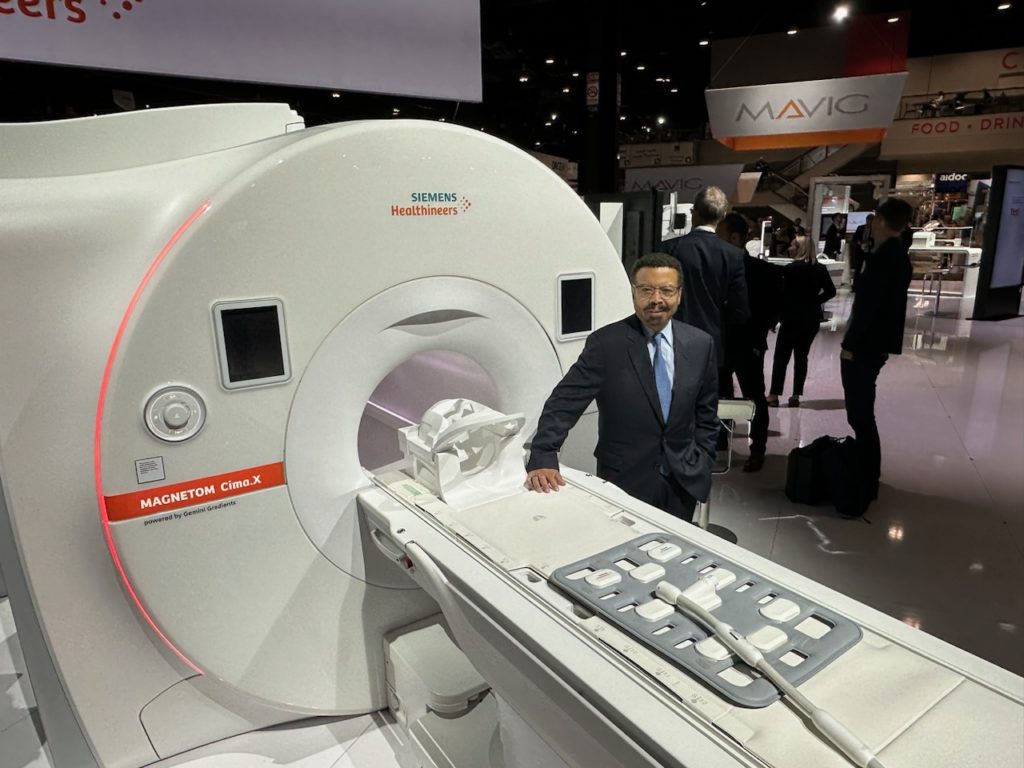What if whole-body scanners could identify threats like early stage cancer and vascular disease long before they become serious health problems?

Health care providers use MRI scanners to diagnose, stage, monitor, and research disease. But what if an MRI could also be used to detect threats early and help prevent severe consequences? A scanner that could see coronary or vascular diseases before they cause a heart attack or stroke, for example, or identify prostate cancer in its earliest stage before a biopsy is done could help maintain health and wellbeing throughout a lifespan.
This was the brainchild of Roderic Pettigrew, the Robert A. Welch Professor and inaugural Dean of the School of Engineering Medicine at Texas A&M University, whose proposal to “push the limits of MRI performance physics to the furthest point allowed by safe execution in the whole body” persuaded Siemens Healthineers to undertake the challenge. Recently Siemens unveiled the 3T Magnetom Cima.X2, an advanced generation MRI scanner that offers unprecedented technical performance features when compared to conventional whole-body MRI systems.
“I realized that even modern MRI scanners had not yet been designed to reach the theoretical ‘summit’ of their performance capabilities,” said Pettigrew. “And that if we reach this summit, it could really improve our ability to identify early disease and prevent deleterious outcomes. Imagine that we could identify vulnerable plaque in arteries before it causes a heart attack or stroke, identify breast cancer even earlier than we can today and minimize the therapeutic intervention, or detect prostate cancer before biopsy to enable earlier treatment with noninvasive techniques.”
Using a powerful magnet with various electromagnetic coils, an MRI works by temporarily magnetizing the body, sending a radiofrequency pulse into the area being imaged to stimulate the magnetized hydrogen in its molecules, then detecting the radiofrequency signal that the excited hydrogen nucleus returns. The signal is similar to one received by an FM radio. A computer processes the signal to make images for clinicians to use throughout biomedicine including neuroscience, musculoskeletal, oncology and cardiovascular applications. The ability to make an image and see fine detail depends on precisely controlled changes in the strength of the magnetic field in various directions. This is called a magnetic field gradient. The speed at which the change is made is called the slew rate.
Presented at the December 2022 RSNA Annual Meeting in Chicago, the Cima, Spanish for “summit,” offers a magnetic field gradient strength of 200 mT/m and a slew rate of 200 mT/m/s. Most conventional systems have a gradient strength for the whole-body only about 20% to 40% as strong as that of the Cima. In an MRI scanner, the amplitude of the magnetic field gradient is a major determinate of the smallest size structure that can be seen, and its sensitivity to motion and water diffusion, while the slew rate, or speed at which the gradient coils pulse, determines the speed of signal formation. This is important for detecting things that happen quickly, like coronary motion. The strong gradients can also make images of microstructures like cardiac fibers clearer. As a result, the Cima could be a powerful tool to help clinicians and scientists better understand and treat highly prevalent problems such as prostate cancer and early-stage cardiovascular disease.
“This is an exciting development in the field of whole-body MRI, and its potential to improve clinical care and research is just beginning to be explored,” said Pettigrew. “Achieving such an advanced MRI system required a fresh design of the whole-body scanner and new tools to build it. This scanner is unique in the world. We hope it will bring new understanding, greater prevention, and improved treatment of human disease.”

